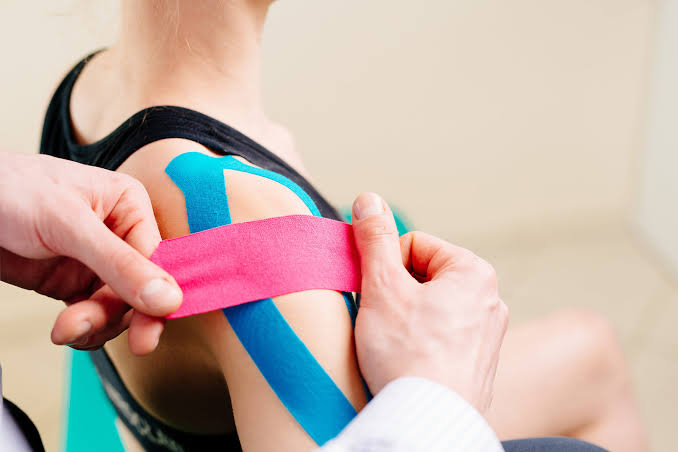Kinesiology tape is an elastic therapeutic tape for temporary relief of musculoskeletal pain and dysfunction caused by muscle strain and joint inflammation. It is applied directly to the skin to support, stabilize, and treat soft tissue injuries. Kinesiology tape is often used by physiotherapists, athletic trainers, doctors, chiropractors, and massage therapists.
For years, physiotherapists have incorporated kinesiology tape into their treatment routines for patients with a variety of health problems, including back pain, stiffness, sports injuries, and more. It is thought that the tape’s elasticity absorbs pressure and stress, while the way the tape sticks to the skin creates a mild compression effect.
Considered by many to be one of the best ways to treat injuries, kinesiology tape is a method of taping that is helping people regain mobility. The tape has a lifting effect on the skin, making it capable of stimulating the muscles underneath. Apart from this, the taping technique has also been shown to relieve pain and improve posture, among other things.
Recovery and Prevention
Physiotherapists use kinesiology tape on their patients to help them recover from injuries. The tape can be used to help realign joints, including the shoulders and knees. Kinesiology tape is a simple and effective way to promote healing—from injuries like strains and sprains to chronic conditions like plantar fasciitis and carpal tunnel syndrome. It works by providing structural support to the underlying tissue, which allows the body to work more efficiently.
The tape also helps slow down the firing rate of pain receptors, which helps to reduce inflammation. As a result, kinesiology taping can be an important tool in a fitness fanatic’s wellness kit—it can help prevent injuries from reoccurring and help your body recover more quickly after an injury has occurred.
Kinesiology tape was designed to help muscle injuries, but it can also prevent injury. It is used to stabilize muscles, ligaments, and tendons and offers support to help prevent injuries and promote healing. The tape can help with your posture and back problems, as well. The problem with the tape is that it can be challenging to apply by oneself, which your physiotherapist can help with.
Alternatively, body part specific pre-cut kinesiology tape is available, which makes for easy application as the user does not have to cut or shape the tape themselves. Kinesiology tape made with quality materials, such as cotton and poly-acrylic adhesive, make it easy to apply and remove. The pain-free removal of the tape leaves no sticky residue.
Pain Relief
Kinesiology tape may be used for almost any condition, but it is most often used to minimize pain and inflammation caused by arthritis, tendinitis, injuries, and other conditions. When applied to the skin, kinesiology tape has an analgesic effect, which means it can help to ease pain by altering nerve responses to create enhanced sensory stimulation in the impacted area.
Support
Whether you’re an Olympian, a weekend warrior, or just work out regularly, you know that physical activity takes a toll on your muscles and joints. Kinesiology tape mimics the way muscles work by mimicking the skin to allow the body to build support and stability. Kinesiology tape is a strong and lightweight tape that provides support and stability for your muscles. It is ideal for endurance athletes as well, as it keeps the muscles warm.
Performance
Kinesiology tape is a great tool for athletes. It can be applied to any muscle in your body and can be worn during any activity. While it is commonly used to treat sprains, strains, or fractures, it also can improve performance. When applied over the muscles used during a specific activity, kinesiology tape can help increase blood flow and restore muscle function, which can reduce fatigue and soreness. It can also improve the ability of specific muscles to contract, along with supporting flexibility in muscles that tend to be over-tight and shorten or tighten under stress.
Common Applications by Physiotherapists
- Ankle: One of the most common uses of kinesiology tape is to treat ankle sprains. This is because the tape is highly flexible and conforms to both the wearer’s skin and the individual contours of the ankle.
- Shoulder: Kinesiology tape is often used to help alleviate the pain and discomfort caused by shoulder injuries. The tape supports the shoulder without impeding its range of motion.
- Knee: Kinesiology tape is commonly used to provide support to the knee by increasing your positional awareness of the joint and restoring normal muscle function to increase your ability to protect your knee and avoid positions that cause injury.
- Neck: When you have neck pain originating from the spine, taping your neck can increase blood flow to the area, and it provides a gentle, gradual pull that can help decompress the spine, which can relieve pressure on the nerves.
- Wrist: Kinesiology tape is a safe and effective alternative treatment for wrist pain by helping to reduce swelling and inflammation and stabilize the joint. It can also be used to treat carpal tunnel syndrome, tendonitis, and other ailments.

The Magic of Kinesiology Tape
Whether it’s getting faster, or jumping higher, or recovering quicker, kinesiology tape has been recommended by physiotherapists as an effective aid to assist with injury prevention, pain relief, and performance. The reason for this is kinesiology tape’s ability to improve muscle function by increasing blood flow to the muscles, which in turn helps the muscles to contract and function more effectively.
The end result is that kinesiology tape has become a great way to help treat some of the most common sports injuries and has become a staple in physiotherapist practices and the locker rooms of many professional and college teams. Consider implementing it in your organization or personal life, if needed.
AUTHOR’S BIO:
Montu Khokhar is the CEO of Toronto-based SpiderTech, a leading manufacturer of pre-cut kinesiology tape and strapless & anti-fog face masks. Mr. Khokhar, like SpiderTech (a branch of NUCAP technologies), is constantly looking to achieve the impossible through innovation and engineering.








